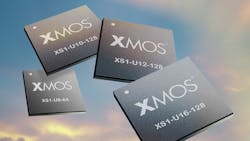Microcontroller Incorporates Fieldbus and I/O
Even if you're just a user of industrial systems rather than a developer, it’s making more and more sense to get up to speed with what’s happening on the embedded front to advance the automation devices you use. Like the CapitalOne commercials that ask “What’s in your wallet?”… can you answer the question: What’s in your controller, sensor, or robot?
I say this because it seems that on a nearly daily basis I’m receiving more news about chip manufacturers targeting the industrial space in a big way. For example, XMOS, a Bristol, U.K.-based fabless semiconductor manufacturer, is focusing on designers of industrial embedded systems with its new xCORE family of multicore microcontrollers, which it says can be used in industrial devices ranging from simple sensors and actuators to protocol bridges, high-performance PLCs, and motor controllers.
xCORE microcontrollers (real-time 32-bit with 8, 16 and 32 cores) feature fieldbus xSOFTip soft peripherals and an industrial serial bus I/O card enabling communication via RS485, CAN and LIN. The fieldbus and I/O features are available via XMOS’s modular sliceKIT development system.
“The industrial market is characterized by a diversity of communication protocols, both standard and proprietary,” says Paul Neil, vice president of product management at XMOS. “The xCORE multicore microcontrollers can be programmed to support these different requirements” whether you’re implementing a proprietary protocol in software, customizing one of the many fieldbus standards, or implementing real-time extensions to a complex networking protocol such as Ethernet, Neil says.
These new fieldbus and I/O card capabilities extend XMOS’s line of software-based xSOFTip products that also include real-time Ethernet, USB, motor and motion control, and human-machine interface (HMI) functions.
Synapticon, a manufacturer of embedded computing products for use in service robots, industrial automation, and other applications requiring parallel and distributed computing resources, uses XMOS products in the systems it develops for customers.
“For timing-critical electromechanical applications, particularly those in which robotic components interact with other real-world elements using sensors, you need a truly real-time solution,” says Nikolai Ensslen, managing director of Synapticon. Ensslen says Synapticon uses xCORE microcontrollers for their ability to support multi-axis, multi-node robotic systems, combining control and inter-node communications functions.
XMOS contends that xCORE’s edge in industrial applications rests in the microcontroller’s ability to combine flexible and time-sensitive communications capabilities with the ability to implement latency-critical control functions. Because industrial control applications need to close multiple asynchronous control loops in real time, often requiring distributed intelligence and communication over real-time networks to do so, XMOS is positioning xCORE as a product that delivers real-time control and communications in a “single, deterministic, multicore architecture supported by an easy-to-use software design flow.”
About the Author
David Greenfield, editor in chief
Editor in Chief

Leaders relevant to this article:
